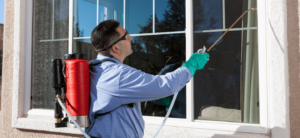Pest Control Ballwin MO is the action of managing a pest to reduce its numbers or damage to an acceptable level. It involves a combination of tactics.

For example, removing sources of food and shelter can deter rats. Blocking their access to water can prevent roaches from breeding. And using traps along a pest’s route can intercept them.
Natural forces act on all organisms and can help or hinder pest control. They include climate, habitat characteristics and landscape features such as mountains, rivers and waterways that limit the movement of some pests, and the availability of food and shelter. Other natural forces affect the life cycle of pests, including the onset of adulthood and the emergence from eggs or larvae. They also include predators and parasites, such as nematodes, fungi and bacterium, which attack the pest, its eggs or larvae, or its host plant. Finally, the environment in which pests are present determines whether they are susceptible to certain environmental factors, such as pheromones or juvenile hormones, that suppress reproduction and development.
Natural enemies can help control pest populations but often there is a lag between increased pest densities and the increase in enemy numbers. Increasingly, farmers are supplementing natural enemy populations by releasing them into the field, but there are limits to how much they can control pests.
Biological methods are designed to mimic the effects of bottom-up natural forces by encouraging the growth and survival of the organisms that naturally control pest populations. They can be used in place of chemicals or in conjunction with them, and include techniques such as the reintroduction of predators and pathogens, the introduction of sterile insects, the use of pheromones, and the introduction of genetically modified enemies.
Upscaling models of natural pest control to landscape scale requires an empirically based framework that links agroecosystem attributes to specific mechanistic processes. Such a framework should facilitate the generation of archetypes that represent major crop-pest-enemy combinations and their underlying ecological processes. The framework should allow for a dynamic definition of these archetypes, lowering the bar for researchers willing to contribute case-specific knowledge. The resulting “living” database should provide the basis for a set of archetypes that are compatible with the range of agricultural landscapes worldwide and can be validated with observed pest and natural enemy responses to land-use gradients (Martin et al., 2019).
Pest Populations
Pests are organisms (such as insects, bacteria, fungi, nematodes or weeds) that harm people or their property. They can devalue crops, destroy lawns and gardens, displace desirable species, contaminate foods or water supplies and affect soil health. They can also be harmful to animals and humans in their vicinity by transmitting disease.
A species may become a pest when it reaches densities that result in unacceptable damage or injury. Any organism that interferes with human activities can be a pest, including plants (such as weeds), invertebrates (such as ants or termites) and vertebrates (such as rodents or birds).
The amount of damage or injury caused by a pest is usually measured in terms of economic loss. This is often referred to as the “action threshold” or economic injury level. entomologists use threshold information to determine when pest control is necessary.
Threshold levels are influenced by a number of factors, including climate, food supply, availability of habitat and natural enemies. Changing any of these factors can lead to increased pest populations.
For example, the destruction of habitat due to agricultural practices and urban development can eliminate shelter for native predators and parasites of pests. This can allow pest populations to increase to outbreak proportions.
A number of different methods can be used to prevent, suppress or eradicate a pest infestation. Preventive methods include frequently cleaning areas where pests are likely to live, removing food sources and water and preventing conditions that encourage pest establishment. Suppression methods reduce the conditions that promote pest growth by restricting activity or population growth through a variety of means such as physical removal, repellents, biological controls and synthetic chemical agents. Eradication is seldom attempted in outdoor pest situations, but it is sometimes a goal in indoor environments such as homes and buildings, schools, and office complexes.
Prevention
Pests can damage crops, food processing facilities and other structures. They also carry diseases that can harm people and animals and disrupt ecological balances. Preventive pest control involves reducing the number of pests or limiting their damage. This is achieved through cultural, biological and chemical means.
The first step in preventive pest control is a thorough inspection by trained technicians. This will identify entry points and potential nesting areas. Then a customized treatment plan will be created to eliminate the specific pests that are plaguing your property. This may include spraying, baiting, or trapping, and will be applied inside and outside your home.
Certain varieties of plants, trees, woods, and animals are more resistant to pests than others. Using these resistant types helps to keep pest populations below harmful levels and minimizes the need for chemicals.
Biological control methods involve introducing natural predators to the environment to reduce the population of targeted pests. Examples of biological control are parasitoids, nematodes, and bacteria. These methods are not as effective as pesticides, but can have a positive impact on the environment.
Chemical pesticides are widely used in the food industry to kill or control weeds, insects and rodents. They are typically sprayed or dusted onto crops or other targets to prevent pests from damaging them. Unfortunately, pests often become resistant to pesticides. This can be due to the development of resistance through mutation or as a result of cross-contamination from other sources.
The food manufacturing industry must be vigilant to avoid pest contamination. This can be done through good factory practice such as regular inspections, pest sighting registers and ensuring that all raw materials entering the food plant are free from pests (as opposed to contaminating finished products). This can also be achieved by implementing effective cleaning, waste management and disinfectant practices.
Suppression
Pest populations can be reduced to acceptable levels using a combination of control tactics. These tactics include:
Biological control is the use of natural enemies, including parasitoids, predators, and pathogens, to suppress pest populations and make them less damaging. This is a common component of integrated pest management programs. Biological control requires extensive research into the biology of potential natural enemies and their behavior, as well as the ecology of the target pest. Once suitable enemies are selected, they must be collected and screened, then reared in large numbers, with attention to the timing of the enemy and pest life cycles, and then released. This is done on a spot or field basis, limiting the areas treated, to minimize contact between natural enemies and pesticides.
Weather conditions affect the growth rate of many pest species. Insects and weeds are often killed or suppressed by rainfall, freezing temperatures, drought, or sudden changes in temperature. Other environmental factors, such as the availability of water or soil nutrients, may also affect pests.
Plants, animals, and other organisms that live on or in pests can also influence their populations. For example, fungi and bacteria can infect insect pests to reduce their feeding activity or kill them. Chemical pheromones can also change the behavior of other insects in an area, influencing their population density.
All of these factors, as well as others not mentioned here, work together to keep pest populations below harmful levels. In addition, some plants, animals, or structures resist certain pests and can help keep their populations low. For example, resistant varieties of crops, wood, or weeds can help prevent pests from destroying them. Proper handling and application of all pest control methods is important to protect people, the environment, and equipment. Using the proper personal protective equipment (PPE), following product labels, and increasing knowledge through continuous learning can improve safety in pest control situations.
Eradication
Eradication is the elimination of a pest population, whether it be an animal, plant, or fungus, from a local area. This is a difficult and time-consuming task that requires a large effort on the part of human beings. A variety of terms are used to describe this action: exterminate, extirpate, eradicate, and uproot. These synonyms are sometimes confusing to those not intimately familiar with eradication efforts. The difference is that exterminate means total annihilation, extirpate implies the extinction of a race or family, and eradicate stresses a forcible removal.
The eradication of a pest species can be difficult to achieve because there are many factors that contribute to disease transmission. These may include the number of people infected, the number of intermediary hosts, and the environmental conditions that influence the reproductive rate of the pest in question. Eradication programs are complex and expensive, but they can be very effective when they are undertaken in an appropriate manner.
When modern pesticides were first developed, they were extremely effective at reducing the abundance of targeted organisms. However, the overuse of these chemicals led to the evolution of resistant pests. As a result, scientists began to focus on the need for a broad array of control methods. These new approaches are referred to as integrated pest management (IPM).
Prevention involves keeping a pest from becoming a problem; suppression is reducing pest numbers below an acceptable level; and eradication is destroying an entire pest population. Preventive measures may include the use of traps for insects and rodents, caulking cracks and crevices around cabinets and baseboards, and removing weeds and debris from garden areas. Also, regular inspection of plants for the presence of insects and rodents can be very helpful. If pests are found, they can be hand-picked before they can cause damage or spread to other plants.

